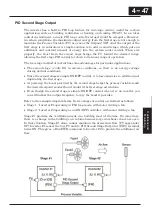
Having two motor profiles lets you store two “personalities” for motors in one inverter’s
memory. The inverter allows the final selection between the two motor types to be made
in the field through the use of an intelligent input terminal function [SET]. This
provides an extra level of flexibility needed in particular situations. See the following
table.
Parameters for the second motor have a function code of the form x2xx. They appear
immediately after the first motor’s parameter in the menu listing order. The following
table lists the parameters that have the second parameter register for programming.
Parameter Codes
Function Name
1st motor
2nd motor
Multi-speed frequency setting
A020
A220
Acceleration (1) time setting
F002
F202
Deceleration (1) time setting
F003
F203
Frequency source setting
A001
A201
Run command source setting
A002
A202
Base frequency setting
A003
A203
Maximum frequency setting
A004
A204
Multi-speed frequency setting
A020
A220
Torque boost select
A041
A241
Manual torque boost value
A042
A242
Manual torque boost frequency adjustment
A043
A243
V/f characteristic curve selection
A044
A244
V/f gain setting
A045
A245
Frequency upper limit setting
A061
A261
Frequency lower limit setting
A062
A262
Acceleration (2) time setting
A092
A292
Deceleration (2) time setting
A093
A293
Select method to use Acc2/Dec2
A094
A294
Acc 1 to Acc 2 frequency transition point
A095
A295
Dec 1 to Dec 2 frequency transition point
A096
A296
Level of electronic thermal setting
B012
B212
Electronic thermal characteristic
B013
B213
Overload restriction operation mode
B021
B221
Overload restriction level setting
B022
B222
Deceleration rate at overload restriction
B023
B223
Source of overload restriction selection
B028
B228
Terminal [1] function
C001
C201
Terminal [2] function
C002
C202
Terminal [3] function
C003
C203
Terminal [4] function
C004
C204
Terminal [5] function
C005
C205
Overload level setting
C041
C241
Motor capacity
H003
H203
Motor poles setting
H004
H204
Motor stabilization constant
H006
H206
4
61
Inverter Mounting
and i
n
st
all
ation
4
−
61
Operations and
Monitoring
















































